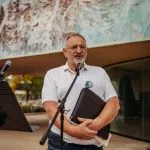
Chronicle of Julian Assange’s stay in the Ecuadorian embassy
LONDON — Julian Assange, the founder of anti-secrecy group WikiLeaks, was arrested at the Embassy of Ecuador in London Thursday — seven years after he first took refuge there.
A look at key events in the Assange saga:
— August 2010: Swedish prosecutor issues arrest warrant for Assange based on one woman’s allegation of rape and another’s allegation of molestation. The warrant was withdrawn shortly, with prosecutors citing insufficient evidence for the rape allegation. Assange denies the allegations.


